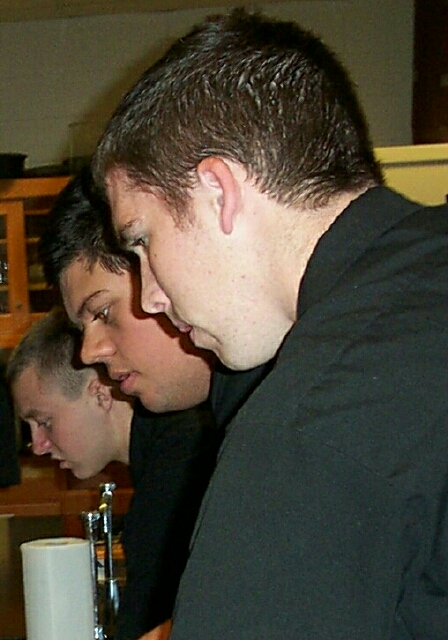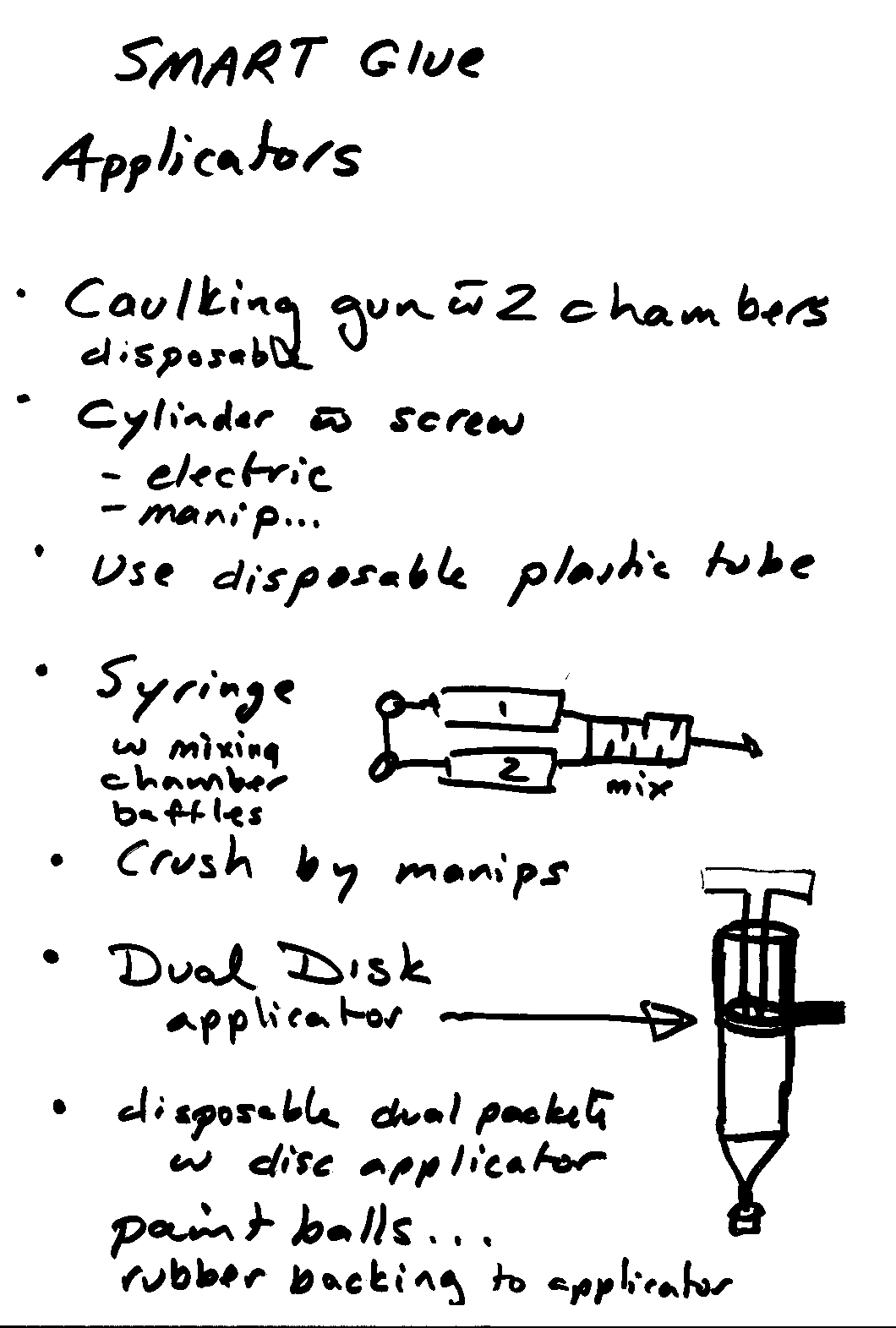|
Report
#6a: Applying epoxy underwater on volcanic rocks collected
by Alvin and brought to our laboratory
This
report prepared by UCCRTS technicians:
On
October 10th we had to identify two expoxies that would stick
to the (volcanic) rock when applied underwater. The two expoxies
included "Smart Glue" and the water proof (Ace Hardware Store)
epoxy putty. Smart Glue is also known as PSI-326 in bulk.
My cadet decided to test glass and plastic in the ambient
temp water. We first got our (safety) equipment and then we
proceeded. We mixed (together) a half teaspoon of both epoxies,
making sure they were mixed very thoroughly. We tried a smooth
+ an etched glass slide, which both bonded to the rock. The
plastic tab bonded to rock. We also tried to get the head
of (a galvanized roofing) nail to bond to the volcanic rock.
I can say that all my tests worked. As a marker to distingush
the rocks from other volcanic rocks, we were asked to try
to write the letters "MMA" in glitter (mixed with epoxy) on
the rock either with a q-tip or a popsicle stick. It was hard
to apply with the q-tip and the stick. If we had a bigger
applicator it would apply (epoxy) better. The gitter (in the
epoxy) worked better in room temperature water (than it did
in) the chilled water.
Ace
water proof epoxy putty (made) a strong bond with the glass
slide to the rock but failed (to bond) the aluminum slab to
the rock. These (tests) were performed in the ambient temp.
seawater. In the ice water, one group of (galvanized roofing)
nails epoxied to a rock succeeded (in sticking). Plastic tabs
bonded to the rock in ice water (NOT SURE).
The
temeratures of the seawater: 14 degrees Celsius
Ambient
air temp: 20 degrees Celsius
Ice
seawater started off at 10 degrees Celsius and decreased to
5 degrees Celsius before our test was completed.
We
went back to the classroom and discussed what we observed
and what we should try (next). (Then) we went (back to) the
lab to try our (new ideas). Our (applicator) was a rubber
glove. My cadet cut a hole in the glove, (put epoxy and glitter
in the glove finger) and squeezed it onto the volcanic rock.
(The epoxy) stuck and (the glove applicator) worked efficiently.
Ambient
Air Temp. 20 degrees C
Ambient
Sea Water 14 degrees C
Chilled
Sea Water 10 degrees C droped to 5 degrees C
ACE WATER PROOF PUTTY
what stuck to the rock what didn't stick
Under Ambient Sea Water
glass slide both etched Alumminum Slide
and smooth
Under Chilled Sea Water
Plastic tab
Nail (nail head down)
Notes: the putty was difficult to apply to the rock itself.
PSI
326, aka SMART GLUE with glitter
what stuck to rock What didn't stick
Under Ambient Sea Water
glass slide both etched
and smooth
Nail (nail head down)
Under Chilled Sea Water
Nail (nail head down)
glass slide both etched
and smooth
plastic tab
Notes:
It (was more difficult to make epoxy bonds) in chilled seawater
than in ambient (temperatures). (The addition of) glitter
made it harder to apply (epoxy) to rock. It was hard to apply
with a Q-Tip or a stick. It worked well when applied with
glove and no glitter added. (The epoxy was extruded through
a hole in the glove finger.) We were able to sprinkle glitter
over the glue once (it was applied to the) rock. when Smart
Glue was mixed, we used 1/2 teaspoon (resin) and 1/2 teaspoon
(hardener). (It) did give off (heat), an exothermic reaction.
I was able to mix it quickly and very well.
Last week two adhesives worked (on rocks). They were Smart
Glue and ACE hardware epoxy putty. The Smart Glue is exothermic
and mixed very well.It wasn't in an applicator so it was hard
to apply or make a letter by (drawing with it like a pen).
We used a popsicle stick and a q-tip to apply it. We put glitter
in the epoxy because it turns clear and the glitter keeps
it visable. we didn't use dye because of the chemical compounds
in dye could disturb the way (the epoxy) applies.
In
the cold water, it was very hard to stick (epoxy) to the rock.
The putty was realy easy to mix and applied very easily as
well. It (putty) would be a lot more efficient to use under
water because the Smart Glue can only be used in 1/2 teaspoon
(quantities). That would cause a problem.
With
both epoxies we put nails head down in the epoxy to see if
it would adhere to that type of metal. All worked well. We
(tried) plastic glove as an applicator. We poked a hole in
the tip of the finger. It worked great!
Report
#6b: Ideas for an epoxy adhesive applicator/marker
Three
brains are better than one!

Report prepared by MMA engineers:
3/C Holcroft
3/C McQueen
Editor's note: See also two ideas reported in Report #5 last week by
2/C Maguire and 3/C Sunde.
This week we were asked to come up with new ideas for some sort of
applicator. I had an idea that was shared with a few of my
classmates. The idea was to use a modified syringe to be able to
inject the epoxy onto a rock or other sample. An idea is to inject
part "A" and part "B" into two separate thin plastic bags while
inside the syringe tube and making the tube airtight. By depressing
the plunger up and down a few times, breaking the bags and mixing
both parts. We could eject the now mixed epoxy by having a break-off
tip and apply where needed.
I found a company (advertisement) in a construction magazine.
They have an epoxy applicator that I think will work. The idea of an
applicator for a two part adhesive is difficult because of the
limits. The idea that I had would be to take a single tube with
two chambers and use an offset mesh plunger that will mix and apply
the epoxy.
First
set of design ideas for applicator are shown below. They are
the result of the first brainstorming session on October 11,
2001.


|

